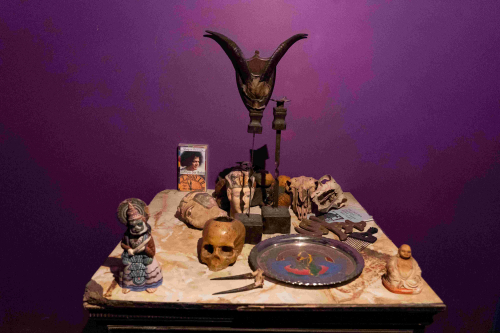Extinction Beckons - Review of Mike Nelson exhibition, Hayward Gallery

Nick Ross reviews this exhibition, on till 7 May at the Hayward Gallery, London. Image above: The Deliverance and The Patience, interior, 2001. Photo by Liam Harrison. Courtesy the artist and the Hayward Gallery
There is a dichotomy that leaps immediately to mind in relation to Mike Nelson’s work. He has established himself as a major force in art’s premier league. He represented Great Britain at the 54th Venice Biennale in 2011 and has shown around the world. He has featured in numerous international exhibitions, including the 13th Biennale of Sydney, the 8th Istanbul Biennial and the 13th Lyon Biennale. The art, though, speaks of something else entirely. It refuses any sense of the hollow grandeur that so much Biennale-focused art represents.
Nelson’s art is scavenged from flea markets, boot fairs, warehouse closures, and the materials are then transformed into installations which represent self-contained worlds. The works stink - of oil, of burned rubber, decommissioned industrial machinery. The title of the show hints at environmental disaster, but extinction is a theme throughout: closed-down workplaces, deserted offices, abandoned studios. Nelson creates installations for us to wander through, but the original inhabitants have all fled in the face of pending disaster, and we are the witnesses to the post-disaster wreckage.
The exhibition begins with a disorientating maze of rooms created within an old container-we loop round, stumbling through a Nairobi travel agency, a sweatshop full of rags, a deserted ship’s bar, a shrine, another one to Elvis. Next we come upon a homeless person’s sleeping bag. The bag is filled with rubble. The political implication - that some of us are just social debris - is obvious.

I, IMPOSTOR (the darkroom), 2011. Various materials. Photo Matt Greenwood. Courtesy the artist and the Hayward Gallery
There is a desert bunker that leads to a studio/darkroom, but the space is too cramped to allow you to properly examine the prints drying in the room. What appears to be another door is blocked -the only way out is by squeezing past those trying to enter.
The politics at the heart of the works are most explicit in the simple display of a roomful of industrial and agricultural equipment gathered from closing down sales in factories and warehouses -everything from filing cabinets via tunnelling bits, cement mixers, through to knitting machines. The post-industrial wreckage of an asset-stripped society. The machines remain, transplanted to a gallery and mounted on plinths, and scavenged four-by-twos, but nothing now can salvage the lives thrown away.
Nelson has also created a fictitious biker gang, made up of Gulf War vets: The Amnesiacs. Some of their bike parts are here, along with a camp fire, with fake flames. The Amnesiacs have had half their memories wiped by trauma. Some of Nelson’s installations are intended to be work constructed by The Amnesiacs as they try to rebuild their memories.
In Nelson’s recreation of one of his workshops (allegedly: after all, how many of us have ever seen or set foot in the original?) you get some idea of the influences behind all this - tattered sci-fi mags, pamphlets by Hakim Bey, heaps of salvaged detritus - a kind of acid anarchism. The anarchist theorist Hakim Bey’s concept of the Temporary Autonomous Zone (a momentarily liberated space )has some relevance here. The TAZ is recreated by Nelson as a realm of the imagination, as a form of resistance even when our attempts to seize the Real are in retreat. (However problematic Bey’s lifestyle anarchism may otherwise be, the TAZ remains a useful battlefield idea.)
The final space in the exhibition shows us what, perhaps, a group of Gulf War vets might create as they try to recover what they’ve seen. We stumble into a room full of wire cells, and hundreds of disembodied/decapitated heads, faces contorted, faces at peace, faces alarmed. A conspiracy theorist rants in the background. There are resonances here of ISIS videos, Guantanamo Bay cells, an appalling, generalised abjection. In Nelson’s exhibition we stumble between worlds founded on delirium and worlds fallen into obsolescence. Instead of trying to show what is, or protest what ought not to be, Nelson pushes nightmares to their extreme- worlds of crisis, madness, laughter, biker trash.
Jean Baudrillard once said that “authenticity was…dissolved amid the random swirl of empty signals.” Maybe that random swirl, which we might also call ideology, is what Nelson captures, the better we might sift through the ruins and make new patterns, plot new paths.

